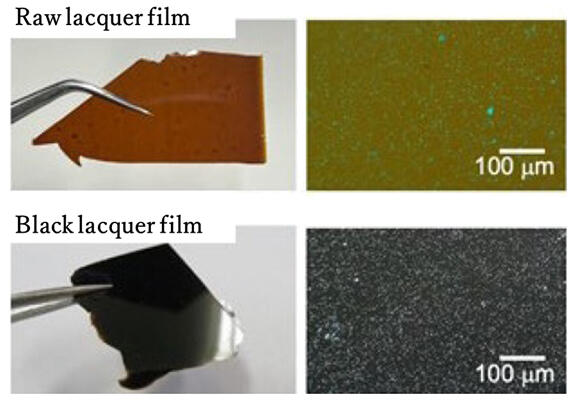The word for "jet black" in Japanese comes from the beautiful, deep black color of black lacquer. Lacquer has been used since the Jomon period, and black lacquer is said to have been used since the Heian period, but the reason for the color of black lacquer was not well understood.
A research group led by Researcher Takuya Nankawa, Assistant Principal Researcher Yurina Sekine and Principal Researcher Daiju Matsumura of the Japan Atomic Energy Agency (JAEA), Assistant Principal Researcher Kosuke Hiroi and Assistant Principal Researcher Shin-ichi Takada of the J-PARC Center, and Visiting Researcher Yoshimi Kamiya and Associate Professor Takayuki Honda of the School of Science and Technology at Meiji University successfully clarified the nanostructure of lacquer by using synchrotron radiation X-rays and neutron beams.
Nankawa commented on the result, "Lacquer is so stable that it has been excavated from Jomon-era ruins and used since ancient times. In this study, we found that the structures of raw lacquer and black lacquer were different. Black lacquer contains 0.3% iron, but some variants are simply mixed with charcoal (carbon). In the future, we would like to analyze cultural relics to determine when true black lacquer was first used."

Provided by JAEA
Lacquer is a naturally occurring material with excellent resistance to water and chemicals and has been used to coat a variety of everyday objects and decorative items. Raw lacquer is composed of urushiol as the main ingredient and water, and takes more than six months to dry, but when iron is added to it, it turns into black lacquer, which dries and hardens in a few days. The surfaces of black lacquer films are so smooth that structural changes are unobservable even under an electron microscope. They are extremely stable and difficult to disassemble for detailed analysis. On the other hand, there are difficulties involved in handling lacquer that is yet to be dried, such as causing lacquer rash. Accordingly, the structure of lacquer has remained unknown.
The research group analyzed a wide range of characteristics of a raw lacquer film and a black lacquer film containing 0.3% iron using synchrotron radiation X-rays and neutron beams. Raw lacquer was found to contain alkyl chains of urushiol stacked on top of each other, while black lacquer undergoes polymerization of the benzene ring of urushiol that originates from a trivalent iron ion. When benzene rings are linked together, the wavelength of the light they absorb changes depending on the length of the linked structure. The structure revealed in this study suggests that the linking of benzene rings generates the black color of black lacquer. Black lacquer is also known to be light-sensitive and will fade upon prolonged exposure to light.
In this study, FT-IR spectroscopy revealed that the double bonds contained in the iron-urushiol polymer and the double bonds in the long-chain hydrocarbons of urushiol are combined in a photoreaction, resulting in the cleavage of the pi-conjugated system and fading.
Nankawa said, "We originally started this research with the idea that a surface treatment using lacquer, which is unique to Japan, could provide covid protection, but a variety of products have been developed for covid protection. On the other hand, there are many things about lacquer that are not clearly understood, and research has been conducted to explore its potential. In the future, we would like to study the production of low-cost black lacquer that does not deteriorate and explore its use as an anti-corrosion material and adhesive."
Journal Information
Publication: Langmuir
Title: Effects of Fe Ions, Ultraviolet Irradiation, and Heating on Microscopic Structures of Black Lacquer Films
DOI: 10.1021/acs.langmuir.3c03412
This article has been translated by JST with permission from The Science News Ltd. (https://sci-news.co.jp/). Unauthorized reproduction of the article and photographs is prohibited.




